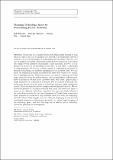| dc.contributor.author | Yan, Bowen | |
| dc.contributor.author | Luo, Jianxi | |
| dc.contributor.author | Alstott, Jeffrey D | |
| dc.contributor.author | Triulzi, Giorgio | |
| dc.date.accessioned | 2017-01-30T19:17:47Z | |
| dc.date.available | 2017-06-19T21:40:54Z | |
| dc.date.issued | 2016-08 | |
| dc.identifier.issn | 0138-9130 | |
| dc.identifier.issn | 1588-2861 | |
| dc.identifier.uri | http://hdl.handle.net/1721.1/106776 | |
| dc.description.abstract | Technology is a complex system with technologies relating to each other in a space that can be mapped as a network. The technology network’s structure can reveal properties of technologies and of human behavior, if it can be mapped accurately. Technology networks have been made from patent data using several measures of proximity. These measures, however, are influenced by factors of the patenting system that do not reflect technologies or their proximity. We introduce a method to precisely normalize out multiple impinging factors in patent data and extract the true signal of technological proximity by comparing the empirical proximity measures with what they would be in random situations that remove the impinging factors. With this method, we created technology networks, using data from 3.9 million patents. After normalization, different measures of proximity became more correlated with each other, approaching a single dimension of technological proximity. The normalized technology networks were sparse, with few pairs of technology domains being significantly related. The normalized network corresponded with human behavior: We analyzed the patenting histories of 2.8 million inventors and found they were more likely to invent in two different technology domains if the pair was closely related in the technology network. We also analyzed the patents of 250,000 firms and found that, in contrast with inventors, firms’ inventive activities were only modestly associated with the technology network; firms’ portfolios combined pairs of technology domains about twice as often as inventors. These results suggest that controlling for impinging factors provides meaningful measures of technological proximity for patent-based mapping of the technology space, and that this map can be used to aid in technology innovation planning and management. | en_US |
| dc.description.sponsorship | SUTD-MIT International Design Centre (IDC) (Grant IDG31300112) | en_US |
| dc.description.sponsorship | Singapore. Ministry of Education (Tier 2 Academic Research Grant T2MOE1403) | en_US |
| dc.publisher | Springer Netherlands | en_US |
| dc.relation.isversionof | http://dx.doi.org/10.1007/s11192-016-2107-y | en_US |
| dc.rights | Article is made available in accordance with the publisher's policy and may be subject to US copyright law. Please refer to the publisher's site for terms of use. | en_US |
| dc.source | Springer Netherlands | en_US |
| dc.title | Mapping technology space by normalizing patent networks | en_US |
| dc.type | Article | en_US |
| dc.identifier.citation | Alstott, Jeff et al. “Mapping Technology Space by Normalizing Patent Networks.” Scientometrics 110.1 (2017): 443–479. | en_US |
| dc.contributor.department | Massachusetts Institute of Technology. Institute for Data, Systems, and Society | en_US |
| dc.contributor.department | Massachusetts Institute of Technology. Media Laboratory | en_US |
| dc.contributor.mitauthor | Alstott, Jeffrey D | |
| dc.contributor.mitauthor | Triulzi, Giorgio | |
| dc.relation.journal | Scientometrics | en_US |
| dc.eprint.version | Author's final manuscript | en_US |
| dc.type.uri | http://purl.org/eprint/type/JournalArticle | en_US |
| eprint.status | http://purl.org/eprint/status/PeerReviewed | en_US |
| dc.date.updated | 2017-01-26T04:48:43Z | |
| dc.language.rfc3066 | en | |
| dc.rights.holder | Akadémiai Kiadó, Budapest, Hungary | |
| dspace.orderedauthors | Alstott, Jeff; Triulzi, Giorgio; Yan, Bowen; Luo, Jianxi | en_US |
| dspace.embargo.terms | N | en |
| mit.license | PUBLISHER_POLICY | en_US |
